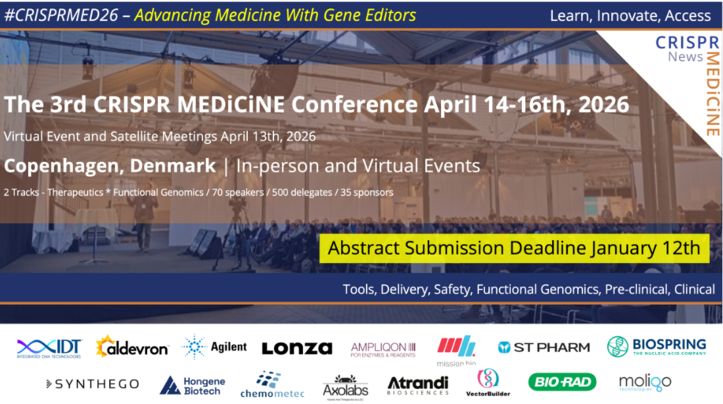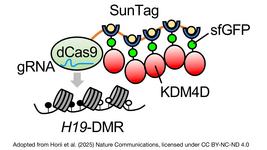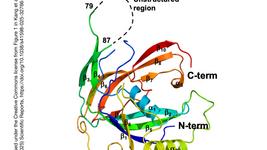CMN Weekly (25 July 2025) - Your Weekly CRISPR Medicine News
By: Gorm Palmgren - Jul. 25, 2025
CMN Intelligence - The World’s Most Comprehensive Intelligence Platform for CRISPR-Genomic Medicine and Gene-Editing Clinical Development
Providing market intelligence, data infrastructure, analytics, and reporting services for the global gene-editing sector. Read more...
Top picks
- In a Nature paper, scientists at Broad Institute of MIT and Harvard and elsewhere report a single-cell CRISPR-Cas platform that simultaneously captures genomic edits, transcriptomic profiles, and surface protein expression to interrogate the functional effects of non-coding disease variants. Applied to primary human T cells, the approach revealed cell-state-specific effects of IL2RA SNPs associated with autoimmunity. By directly linking precise DNA edits with downstream cellular phenotypes, this multimodal system overcomes the challenges of editing heterogeneity and background noise, enabling robust identification of causal regulatory alleles. The platform provides a robust framework for variant-to-function studies in primary human cells, thereby enhancing our understanding of the genetic basis of complex diseases.
- A new platform, BACTRINS, employs CRISPR-associated transposases delivered via conjugation to simultaneously inactivate pathogen virulence genes and integrate therapeutic payloads in situ. Applied to a Shiga toxin-producing Enterobacteriaceae strain, it achieved targeted gene disruption and nanobody insertion without killing host cells. A single dose neutralised toxin expression and improved survival in mice, demonstrating precise, programmable microbiome editing with therapeutic potential.
Research
- A degradable Cas9 system (Cas9-d) was developed to enable drug-inducible control of genome editing. Using pomalidomide to trigger degradation, Cas9 levels dropped within 4 hours, reducing on-target edits 3–5-fold, yet were restored within 24 hours after drug removal. Editing remained effective and safe in various human cells, offering a reversible, low-toxicity method to modulate CRISPR-Cas9 activity for research and therapeutic use.
- Fusion of T5 exonuclease to compact Cas12f proteins produced exoCasMINI and exoRhCas12f1, markedly enhancing genome editing efficiency up to 21-fold without compromising specificity. exoCasMINI matched or exceeded SpCas9 and LbCas12a in activity, enabling efficient gene disruption and oncogene integration in vivo. These compact, high-performance editors provide a promising platform for therapeutic genome editing, where delivery constraints are particularly critical.
- An American study has found that in HIV-1-infected humanised mice, viral rebound after dual long-acting ART and CRISPR-Cas9 therapy is driven by ART-induced mutations rather than CRISPR escape. Sequencing revealed significant divergence in HIV-1 env and the emergence of drug resistance mutations, with no evidence of CRISPR-specific edits. These findings highlight ART-driven viral evolution as the primary cause of rebound, limiting the current efficacy of CRISPR-based eradication strategies.
- Prime editing has corrected ATP1A3 mutations in mouse models of alternating hemiplegia of childhood (AHC), restoring ATPase activity and reducing neurological symptoms. Delivered via AAV9, prime editing achieved up to 85% DNA correction in CNS cells, extended lifespan, and improved motor and cognitive function. The results support the use of a one-time, in vivo CRISPR-based therapy for AHC with minimal off-target effects.
Screening
- CRISPR-Cas9 screening identified PTGR2 as a key modulator of sunitinib resistance in clear cell renal cell carcinoma. PTGR2 knockdown sensitised tumour cells to sunitinib and suppressed tumour growth via downregulation of KDM6A. Disruption of the PTGR2-KDM6A axis offers a potential therapeutic strategy to overcome resistance and enhance sunitinib efficacy in ccRCC.
Clinical and preclinical
- Korro Bio’s KRRO-110 has received orphan drug designation from the EMA for treating Alpha-1 Antitrypsin Deficiency. The RNA-editing therapy, now in Phase 1/2a trials, uses ADAR to correct a SERPINA1 mutation, aiming to restore normal AAT protein levels. The designation follows prior FDA approval and supports further clinical development, with interim data from the REWRITE study expected in late 2025.
- The FDA has granted Orphan Drug Designation to Precision BioSciences’ PBGENE-DMD, an ARCUS-based in vivo gene editing therapy targeting Duchenne muscular dystrophy. Delivered via a single AAV, PBGENE-DMD excises exons 45–55 to restore near full-length dystrophin. Preclinical models showed robust functional gains. The therapy could benefit up to 60% of DMD patients, with the first clinical data expected in 2026.
- Orbital Therapeutics has used a CRISPR-Cas-inspired in vivo RNA platform to encode a CD19-targeted CAR within circular RNA, achieving complete B cell depletion in primates. Delivered via lipid nanoparticles, OTX-201 reprogrammes immune cells without ex vivo manipulation. The data support its potential in treating B-cell-driven autoimmune diseases, with clinical trials planned for 2026.
Industry
- A third death tied to Sarepta’s AAV-based gene therapy, SRP-9004, for LGMD type 2D/R3 has been confirmed, caused by liver failure. Though not involving gene editing, the incident may further erode public confidence in genetic interventions, including CRISPR-Cas approaches, by fuelling broader safety concerns. Regulators have been informed as scrutiny of gene therapy trial risks intensifies.
- Eli Lilly has successfully completed its tender offer to acquireVerve Therapeutics, securing 55.7% of Verve’s outstanding shares at $10.50 per share plus a contingent value right of up to $3.00. All conditions were met, and the acquisition is set to finalise on 25 July 2025.
- Synthegohas been acquired by funds managed by Perceptive Advisors, with the transaction closing on 18 July 2025. The company will retain its leadership, operations, and branding under the new ownership. Backed by strengthened financial resources, Synthego plans to expand its CRISPR product portfolio, including its new GMP-grade SpCas9, eSpOT-ON, and Accubase enzymes, which support therapeutic innovation worldwide.
Perspectives
- A Spotlight in Developmental Cell describes how Cas12a knock-in mice enable efficient multiplex CRISPR genome editing in vivo and ex vivo by expressing high-fidelity Cas12a variants from the Rosa26 locus. This platform enables the simultaneous targeting of multiple genes using crRNA arrays, offering broad tissue editing capabilities that encompass immune cells and hepatocytes. Compatible with AAV and lipid nanoparticle delivery, it facilitates disease modelling and therapeutic development across various tissues.
Detection
- CRISPR-Cas systems have been integrated with personal glucose meters (PGMs) for nucleic acid detection at the point of care. Cas12a and Cas13a enable collateral cleavage to release invertase, converting sucrose to glucose for signal readout. Amplification-free formats show promise but face challenges related to sensitivity and reproducibility. With further optimisation, CRISPR-Cas-PGM platforms could support accessible, low-cost diagnostics for infectious and genetic diseases.
- A photo-controlled CRISPR-Cas12a diagnostic tool was developed using NPOM-caged crRNAs at position 4 of the direct repeat, effectively suppressing premature cleavage. Light activation restores activity, enabling precise one-pot detection without interfering with the amplification process. Combined with a crRNA splinting strategy, this platform allows broad target adaptability, offering a low-cost, universal, and efficient approach for CRISPR-based molecular diagnostics.
- A CRISPR-Cas12a-based assay, combined with RT-RPA, enabled the rapid and sensitive detection of Mayaro virus (MAYV) with high specificity and no cross-reactivity to YFV or CHIKV. Operating at 40 °C, the system achieved detection within 35 minutes and identified as few as 10³ viral copies. This low-cost, isothermal platform offers a promising POC diagnostic for early MAYV identification in resource-limited settings.
To get more CRISPR Medicine News delivered to your inbox, sign up to the free weekly CMN Newsletter here.
“The CRISPR Medicine Consortium is quietly gathering under the CMN umbrella. Exploring the frontier of gene editing for therapeutic precision — this network is not public yet, but it’s real. Watch the signals, track the sequences. Only those who search will know.”R
Tags
ArticleMissing linksNewsCMN WeeklyEli LillyKorro BioPrecision BioSciences, Inc.SynthegoVerve Therapeutics, Inc.
CLINICAL TRIALS
IND Enabling
Phase I
Phase II
Phase III
Gastric Cancer and Colorectal Cancer, CRC, (NCT07166263)
Sponsors:
Base Therapeutics (Shanghai) Co., Ltd.
Sponsors:
Base Therapeutics (Shanghai) Co., Ltd.
IND Enabling
Phase I
Phase II
Phase III
Relapsed or Refractory Acute Myeloid Leukemia, AML, (NCT06541444)
Sponsors:
Base Therapeutics (Shanghai) Co., Ltd.
Sponsors:
Base Therapeutics (Shanghai) Co., Ltd.
IND Enabling
Phase I
Phase II
Phase III







